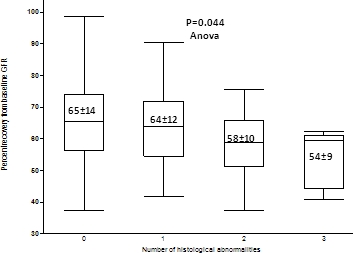Implications of Living Donor Kidney Histology, Volume and Function on Post-Donation GFR
1Glickman Urological & Kidney Institute, Cleveland Clinic, Cleveland, OH
2CWRU School of Medicine, Cleveland, OH.
Meeting: 2015 American Transplant Congress
Abstract number: 300
Keywords: Donation, Kidney transplantation, Outcome, Renal function
Session Information
Session Name: Concurrent Session: Kidney: Living Donor Issues II
Session Type: Concurrent Session
Date: Monday, May 4, 2015
Session Time: 4:00pm-5:30pm
 Presentation Time: 4:36pm-4:48pm
Presentation Time: 4:36pm-4:48pm
Location: Terrace IV
Living kidney donor transplantation is the best modality for treating ESRD as it confers excellent outcomes to patients and it is safe for donors. Postdonation GFR is important as it might relate to long-term donor outcomes. We therefore studied how demographic and renal factors impact postdonation GFR.
We studied 220 living donors with data on predonation GFR, kidney volume and renal histology and who had >6 mo of f/u after nephrectomy (median of 438 days, IQR 319-752 days). Kidney volume was derived from CT scans, predonation GFR was measured by 125I-iothalamate clearance (iGFR) and renal histology was assessed at time of implantation. Abnormal histology was defined as any one or more of the following: >5% glomerulosclerosis (GS), >5% interstitial fibrosis/tubular atrophy (IFTA), or any arteriosclerosis (AS). Univariable and multivariable analysis were used to assess the associations b/w donor variables with percent renal function recovery at f/u.
Donor age was 42±11 yo, 41% were male and 11% were AA. Kidney volume was 363±70 cc and predonation iGFR was 107±18 ml/min/1.73m2. A normal implant biopsy was seen in 59% of donors. GS, IFTA and AS were seen in 22%, 13% and 42% of donors, respectively. At last f/u eGFR was 68±14 ml/min/1.73m2 representing 63±13% from baseline. Higher postdonation GFR recovery was statistically associated with donor age (-0.23% per yr of age, p=0.005), male (67±8% vs 61±15%, p<0.001), kidney volume (0.3% per 10cc, p=0.027), predonation GFR (-2.5% per 10 ml/min, p<0.001), and donors with normal vs abnormal histology (65±14% vs 62±12%, p=0.044). Donor age and histology were highly correlated (p<0.001). The number of histological abnormalities was associated with GFR recovery (figure). In a multivariable model, donor kidney function, histology and volume remained independently associated with GFR recovery.

In conclusion, donor age, renal mass and predonation GFR along with renal histology at time of implantation are independent determinants of GFR recovery.
To cite this abstract in AMA style:
Zaky Z, Lankowsky B, Shah S, Herlitz L, Chiesa-Vottero A, Wallenfelsz K, Caplin A, Goldfarb D, Flechner S, Schold J, Poggio E. Implications of Living Donor Kidney Histology, Volume and Function on Post-Donation GFR [abstract]. Am J Transplant. 2015; 15 (suppl 3). https://atcmeetingabstracts.com/abstract/implications-of-living-donor-kidney-histology-volume-and-function-on-post-donation-gfr/. Accessed January 4, 2026.« Back to 2015 American Transplant Congress
